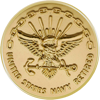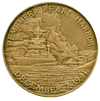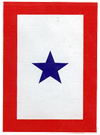| Service Photo |
Service Details |
|
|
|
|
|
| Last Photo |
Personal Details
|
|
|
Home State

Texas | |
|
Year of Birth
1917 |
| |
This Military Service Page was created/owned by
Steven Loomis (SaigonShipyard), IC3
to remember
WOLFE, Malcolm (DFC), CAPT.
If you knew or served with this Sailor and have additional information or photos to support this Page, please leave a message for the Page Administrator(s) HERE.
|
| |
|
Contact Info
|
Home Town
Aransas Pass, Texas |
Last Address
Riverside National Cemetery
Riverside CA
|
Date of Passing
Sep 03, 2004 |
|
|
|
|
|


|
|
|


|
Last Known Activity:
Captain Malcolm E. Wolfe
WWII Navy fighter pilot
Malcolm E. Wolfe stood watch on the deck of a Navy destroyer on a quiet evening, diverting his eyes into a textbook.
Given a choice, he would have been in a college classroom, pursuing an education that had been denied him for lack of money.
A first class petty officer noticed his interest in the book and asked if he had ever heard of the U.S. Naval Academy. He hadn't.
But by the end of the evening, the Texas farm boy who had graduated at the top of his high school class was filing an application for a Naval Academy entrance exam.
The application, radio-telegraphed from the ship, reached its destination minutes before the midnight deadline.
Malcolm E. Wolfe passed the fleet examination, spent a year in a preparatory school and graduated in the 1941 Naval Academy class.
He would go on to earn the Distinguished Flying Cross and two Air Medals as a World War II fighter pilot during a naval career that spanned 31 years.
He was a Pearl Harbor Survivor and entered flight training after the Japanese attack on Pearl Harbor and was assigned to Bombing Squadron 10 aboard the aircraft carrier Intrepid in 1944.
On his squadron's first combat mission, Capt. Wolfe's executive officer was shot down. Capt. Wolfe took the wounded officer's command and went on to earn a Distinguished Flying Cross for action against Japanese forces in the Inland Sea in March 1945.
He was cited for his attack on two Japanese battleships and a carrier amid anti-aircraft fire and the threat of enemy aircraft.
In 1947, Capt. Wolfe returned to his first love, aircraft, as a test pilot of some of the Navy's first jets. He was the 23rd aviator to test-fly the McDonnell Douglas Banshee at Patuxent River Naval Air Test Center in Maryland.
Capt. Wolfe returned to the Naval Academy in 1956 to direct the academic division of the Executive Department, which preceded the Naval Leadership and Law Department.
During his two-year assignment, he hired the department's first civilian instructors and wrote "Selected Readings in Naval Leadership" and "Naval Leadership."
Translated for use by foreign navies, the books were especially popular in Japan and China. By 2002, more than 70,000 copies of "Naval Leadership" had been published in Japanese for use by the Japanese Maritime Defense Force.
In 1965, Capt. Wolfe retired from active duty as a member of the Pacific Fleet Board of Inspection and Survey at San Diego Naval Training Center, where he had begun his career as an enlisted man in 1934.
See: OBITUARY (biography) for more details.
|
| |
Other Comments:
NAVAL ACADEMY SPECIAL AWARDS
Captain Malcolm E. Wolfe Naval Leadership Prize
The Captain Malcolm E. Wolfe Naval Leadership Prize is presented to that midshipman of the graduating class who is determined by the Commandant to stand highest in leadership, conduct and aptitude for commissioning. The award is funded by royalities from the sale of Naval Leadership, thanks to the generosity of the author, Captain Malcolm E. Wolfe, Class of 1941.
|
| |
|
|
|
|
|
|
|
|
|
|
|
 |
 |
1934-1934, HQ, RTC (Cadre/Faculty Staff) San Diego, CA
|
 |
1944-1945, VB-10
|
 |
1944-1945, USS Intrepid (CV-11)
|
 |
1947-1947, Naval Air Station (NAS) Patuxent River, MD
|
 |
1951-1952, VA-174 Hell Razors
|
 |
1956-1958, US Naval Academy Annapolis (Faculty Staff)
|
 |
1964-1965, Board of Inspection and Survey (INSURV)
|
 |
|
|
|
|
|
|
Reflections on CAPT WOLFE's
US Navy Service
|
| |
|
TO THE BEST OF YOUR KNOWLEDGE, WHAT INFLUENCED HIS/HER DECISION TO JOIN THE NAVY?
Baylor University had offered him a scholarship after he graduated from his Nagodoches, Texas, high school. "It would have covered the tuition, but he couldn't pay the rest," a son said.
As the youngest of nine children in the family of a tenant farmer, Capt. Wolfe had gone to school without shoes until the 10th grade. In the midst of the Depression, joining the military appeared to be his best option.
|
TO THE BEST OF YOUR KNOWLEDGE, PLEASE DESCRIBE THE DIRECTION OR PATH HE/SHE TOOK IN HIS/HER MILITARY SERVICE. WHERE DID THEY GO TO BOOT CAMP AND WHAT UNITS, BASES, SHIPS OR SQUADRONS WERE THEY ASSIGNED TO? WHAT WAS HIS/HER REASON FOR LEAVING?
Capt. Malcolm E. Wolfe, 87; WWII Navy fighter pilot. Enlisted to Commissioned Officer:
Malcolm E. Wolfe stood watch on the deck of a Navy destroyer on a quiet evening, diverting his eyes into a textbook. Given a choice, he would have been in a college classroom, pursuing an education that had been denied him for lack of money. A first class petty officer noticed his interest in the book and asked if he had ever heard of the U.S. Naval Academy. He hadn't. But by the end of the evening, the Texas farm boy who had graduated at the top of his high school class was filing an application for a Naval Academy entrance exam.
The application, radio-telegraphed from the ship, reached its destination minutes before the midnight deadline. Malcolm E. Wolfe passed the fleet examination, spent a year in a preparatory school and graduated in the 1941 Naval Academy class. He entered flight training after the Japanese attack on Pearl Harbor and was assigned to Bombing Squadron 10 aboard the aircraft carrier Intrepid in 1944.
On his squadron's first combat mission, Capt. Wolfe's executive officer was shot down. Capt. Wolfe took the wounded officer's command and went on to earn a Distinguished Flying Cross for action against Japanese forces in the Inland Sea in March 1945.
He was cited for his attack on two Japanese battleships and a carrier amid anti-aircraft fire and the threat of enemy aircraft.
After the war, Capt. Wolfe's first major mission was staff navigator of Operation High Jump, a Navy exercise in Antarctica led by Adm. Richard E. Byrd. The mission, designed to prepare the U.S. military to fight the Soviet Union in polar conditions, involved 4,700 men on 13 ships and 33 aircraft and it pioneered the use of icebreakers and helicopters.
In 1947, Capt. Wolfe returned to his first love, aircraft, as a test pilot of some of the Navy's first jets. He was the 23rd aviator to test-fly the McDonnell Douglas Banshee at Patuxent River Naval Air Test Center in Maryland.
Capt. Wolfe returned to the Naval Academy in 1956 to direct the academic division of the Executive Department, which preceded the Naval Leadership and Law Department. During his two-year assignment, he hired the department's first civilian instructors and wrote "Selected Readings in Naval Leadership" and "Naval Leadership."
Translated for use by foreign navies, the books were especially popular in Japan and China. By 2002, more than 70,000 copies of "Naval Leadership" had been published in Japanese for use by the Japanese Maritime Defense Force.
In 1965, Capt. Wolfe retired from active duty as a member of the Pacific Fleet Board of Inspection and Survey at San Diego Naval Training Center, where he had begun his career as an enlisted man in 1934.
|
IF HE/SHE PARTICIPATED IN ANY MILITARY OPERATIONS, INCLUDING COMBAT, HUMANITARIAN AND PEACEKEEPING OPERATIONS, TO THE BEST OF YOUR KNOWLEDGE, PLEASE DESCRIBE THOSE YOU FEEL WERE THE MOST SIGNIFICANT TO HIM/HER AND, IF LIFE-CHANGING, IN WHAT WAY.
On his squadron's first combat mission, Capt. Wolfe's executive officer was shot down. Capt. Wolfe took the wounded officer's command and went on to earn a Distinguished Flying Cross for action against Japanese forces in the Inland Sea in March 1945.
He was cited for his attack on two Japanese battleships and a carrier amid anti-aircraft fire and the threat of enemy aircraft.
|
FROM THEIR ENTIRE MILITARY SERVICE, DESCRIBE ANY PERSONAL MEMORIES, YOU MAY BE AWARE OF, WHICH IMPACTED HIM/HER THE MOST.
He was cited for his attack on two Japanese battleships and a carrier amid anti-aircraft fire and the threat of enemy aircraft.
|
WHAT PROFESSIONAL ACHIEVEMENTS DO YOU BELIEVE HE/SHE WAS MOST PROUD OF FROM HIS/HER MILITARY SERVICE?
He earned the Distinguished Flying Cross and two Air Medals as a World War II fighter pilot during a naval career that spanned 31 years.
|
OF ALL THE MEDALS, AWARDS, FORMAL PRESENTATIONS AND QUALIFICATION BADGES HE/SHE RECEIVED, WHICH WERE THE MOST MEANINGFUL TO HIM/HER AND WHY?
He was cited for his attack on two Japanese battleships and a carrier amid anti-aircraft fire and the threat of enemy aircraft. He earned the Distinguished Flying Cross and two Air Medals as a World War II fighter pilot.
|
IF KNOWN, PLEASE LIST ANY INDIVIDUAL(S) FROM HIS/HER TIME IN THE MILITARY WHO STOOD OUT AS HAVING THE MOST POSITIVE IMPACT ON THEM AND WHY?
The Petty Officer of the Watch, who assisted in getting Malcolm Wolfe appointed to the Naval Academy.
Malcolm E. Wolfe stood watch on the deck of a Navy destroyer on a quiet evening, diverting his eyes into a textbook. Given a choice, he would have been in a college classroom, pursuing an education that had been denied him for lack of money. A first class petty officer noticed his interest in the book and asked if he had ever heard of the U.S. Naval Academy. He hadn't. But by the end of the evening, the Texas farm boy who had graduated at the top of his high school class was filing an application for a Naval Academy entrance exam.
The application, radio-telegraphed from the ship, reached its destination minutes before the midnight deadline. Malcolm E. Wolfe passed the fleet examination, spent a year in a preparatory school and graduated in the 1941 Naval Academy class. He would go on to earn the Distinguished Flying Cross and two Air Medals as a World War II fighter pilot during a naval career that spanned 31 years.
|
ARE YOU AWARE OF ANY PARTICULAR INCIDENT FROM HIS/HER SERVICE, WHICH MAY OR MAY NOT HAVE BEEN FUNNY AT THE TIME, BUT STILL MADE THEM LAUGH LATER ON?
More interesting than funny.
Captain Malcolm E. Wolfe Naval Leadership Prize
The Captain Malcolm E. Wolfe Naval Leadership Prize is presented to that midshipman of the graduating class who is determined by the Commandant to stand highest in leadership, conduct and aaptitude for commissioning. The award is funded by royalities from the sale of Naval Leadership, thanks to the generosity of the author, Captain Malcolm E. Wolfe, Class of 1941.
|
IF HE/SHE SURVIVED MILITARY SERVICE, WHAT PROFESSION(S) DID HE/SHE FOLLOW AFTER DISCHARGE?
Settling in Point Loma, he earned a master's degree and teaching credential at San Diego State College. Then he joined the faculty at Coronado High School, where he taught science and math for 12 years.
In retirement, Capt. Wolfe wrote his memoirs, which he titled "Splicing the Mainbrace." A detailed account of his naval career, it exceeded 400 pages and was published in 2003 by Authorhouse Publishing.
|
IF KNOWN, WHAT MILITARY ASSOCIATIONS WAS HE OR SHE A MEMBER OF, IF ANY? ARE YOU AWARE OF ANY SPECIFIC BENEFITS THEY DERIVED FROM THEIR MEMBERSHIPS?
United States Naval Academy Alumni Association 1941.
|
IF HE/SHE SURVIVED MILITARY SERVICE, IN WHAT WAYS DO YOU BELIEVE HIS/HER SERVING IN THE MILITARY INFLUENCED THE WAY THEY APPROACHED THEIR PERSONAL LIFE, FAMILY LIFE AND CAREER?
Captain Malcolm E. Wolfe Naval Leadership Prize
The Captain Malcolm E. Wolfe Naval Leadership Prize is presented to that midshipman of the graduating class who is determined by the Commandant to stand highest in leadership, conduct and aaptitude for commissioning. The award is funded by royalities from the sale of Naval Leadership, thanks to the generosity of the author, Captain Malcolm E. Wolfe, Class of 1941.
|
IF THEY WERE HERE TODAY, WHAT ADVICE DO YOU THINK HE OR SHE WOULD GIVE TO THOSE WHO FOLLOWED IN THEIR FOOTSTEPS AND RECENTLY ENTERED MILITARY SERVICE?
Share your knowledge.
The Captain Malcolm E. Wolfe Naval Leadership Prize is presented to that midshipman of the graduating class who is determined by the Commandant to stand highest in leadership, conduct and aaptitude for commissioning. The award is funded by royalities from the sale of Naval Leadership, thanks to the generosity of the author, Captain Malcolm E. Wolfe, Class of 1941.
|
HOW EFFECTIVE HAS TOGETHERWESERVED.COM BEEN IN HELPING YOU RECORD YOUR REMEMBERED PERSONS MILITARY SERVICE? DO YOU HAVE ANY ADDITIONAL COMMENTS OR SUGGESTIONS YOU WOULD LIKE TO MAKE?
This is a remembrance profile for Captain Malcolm E. Wolfe, WWII Navy fighter pilot.
|
|


